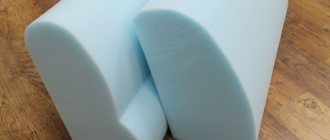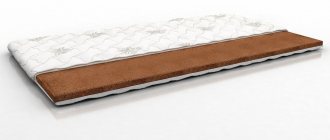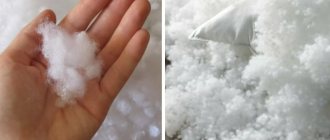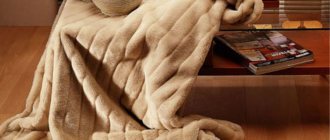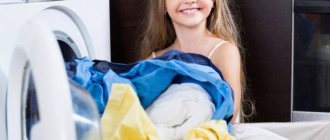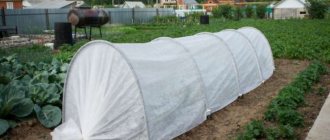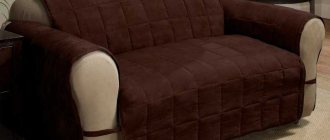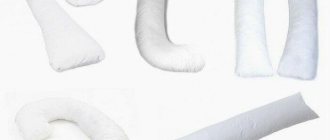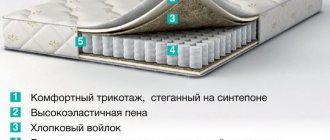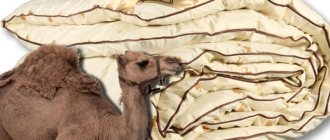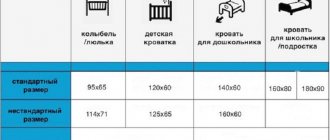A little history
"Flock" means "lint". This word is of English origin and is translated as “tuft”, “bun”, “comb”, “fluff”.
The so-called flocking method was developed in China many centuries ago. Its essence is as follows: production waste (scraps of wool or cotton) is glued onto a base fabric.
At the beginning of the 20th century, the method spread throughout the world. Modern light industry technologies make it possible to use flocking to create different types of material from a wide range of raw materials, both artificial and natural.
Features of fabric production
The canvas consists of two parts. The first is a dense load-bearing base, the second is the pile.
The production process takes place in three stages.
Pile cutting
The following methods for obtaining the top layer are popular:
- grinding raw materials into fractions;
- cutting threads laid into bundles.
In both cases, the output is a soft, uniform fiber.
Coloring
This stage sometimes precedes slicing.
Flock lends itself well to painting in any color. In this regard, velor is inferior to it.
The use of high-quality dyes adds advantages to the fabric such as:
- moisture resistance;
- immunity to ultraviolet radiation;
- resistance to some chemical compounds.
Fabric processing
At the last stage, the two components are combined into one. Processing is carried out in three substages:
- Pile activation. To ensure that the scraps lie flat on the base layer, they are electrified by charging them with special equipment.
- Spraying. The base is covered with a special glue, then sprinkled with a layer of pile.
- Consolidation. The resulting fabric is treated with a special compound. This makes it uniform, attractive and more functional.
Composition variations
There are the following types of material, depending on the constituent raw materials. Flock happens:
- Mixed. The most popular and versatile fabric. It consists of a nylon pile and a cotton base mixed with synthetics (polyester, polyamide or viscose). The ratio is 35% to 65%.
- Cotton. It has a low price, but also low performance indicators. Therefore, the main functions of using such a canvas are decorative and short-term purposes.
- Polyamide. Popular in furniture production. The only weakness is its lack of resistance to ultraviolet radiation.
- Polyester. The properties of such flock are similar to polyamide. Distinctive features: resistance to fading, but difficult to paint in any color except black.
- Viscose. The main disadvantage is wrinkleability.
- Acetate. It has the same disadvantages as viscose. Used to produce artificial fur.
- Polypropylene. It has low performance indicators and is convenient for large-scale production.
Types of flock depending on composition
There is a classification of fabric according to the raw materials from which the material is made. The flock could be as follows:
- mixed. This type has universal properties and is the most popular in the consumer market. It consists of nylon pile and a cotton-synthetic base made of cotton, polyester, polyamide or viscose. Natural and artificial fibers are in a 1:2 ratio;
- cotton It is inexpensive, but has low performance properties: poor wear resistance, prone to pile abrasion and getting wet. Used only for decorative purposes or short-term use;
- polyamide. It has good performance characteristics, softness, and excellent appearance. The fibers do not wrinkle or wear out. An easily dyed material, but resistant to ultraviolet radiation, which causes fading of the fabric. Finds popularity in furniture upholstery, and when placed away from sunlight it can last a very long time;
- polyester. It has all the positive qualities of polyamide flock, is not afraid of UF rays, but does not stain well, so it has a limited selection of dark colors;
- polypropylene. An inexpensive type of flock that has low performance indicators: tendency to wrinkle, instability to wear ;
- viscose. Produced from artificial raw materials, it has the characteristics of polypropylene flock;
- acetate. This is a type of fleecy fabric that has the disadvantages of viscose flock, but has found its use for producing faux fur.
Important! A special type of material – flock on flock – has a chic look. Instead of the usual layer of fibers, two are glued, and the second layer is applied selectively in a certain order, which forms a pattern on the surface. The fabric turns out even softer, more embossed, and forms highlights and halftones on the surface.
Variety of fabrics
Modern flock is quite variable. The material can be soft or hard, different in thickness, thickness of the top layer, etc. The determining role in this is played by the pile, or more precisely:
- thickness;
- length;
- density (frequency of spraying).
Color options are not limited.
Nowadays, new unusual flock fabrics have appeared. Among them:
- Aramid. It is distinguished exclusively by yellow color. The application is highly specific.
- Carbon fiber flock. It is characterized by absolute non-flammability (without special processing required for other types). More expensive than other flock fabrics.
Similarities and differences between the two materials
Although completely different in composition, the two types of fabric are similar in properties. Both velor and flock look like velvet and are equally pleasant to the touch - soft and fluffy. Both materials are durable and do not fade in the sun.
However, completely natural velor differs from synthetic flock not only in composition, but also in the manufacturing method. Velor is woven using a weave of five threads: four form the face and back, the fifth forms the pile. Flock is a non-woven fabric when a velvety surface is applied to polyester by spraying. Impregnations are also used - with their help, the fabric is supplied with layers that reject moisture and dirt.
Thus, if velor remains a “breathable” material, then flock is more moisture resistant and less susceptible to abrasion.
Advantages of flock
Among the several advantages of this material:
- High density, and due to this - strength. Flock products are difficult to tear and damage in any way.
- Water resistance. The fabric literally repels moisture.
- Breathability. Maximum characteristic of mixed flock.
- Wear resistance. The fabric does not wear out, does not stretch, does not pill, and does not shrink.
- Heat resistance. Temperature changes are not dangerous for the material.
- Softness. Flock products are warm and pleasant to the touch.
- Attractive appearance.
- Easy to maintain and clean.
- Wide possibilities in coloring (the advantage does not apply to aramid and polyester varieties).
pros
- Looks elegant . Any flock shoes - not only boots or boots of diligent workers or shoes of ambitious businesswomen, but also ankle boots of sophisticated fashionistas - look elegant. Even budget models look very kosher for their price.
- Softness . It does not require preliminary breaking in before wearing, since even when put on for the first time it does not compress the foot. The pair fits comfortably around the leg without creasing or chafing.
- Waterproof . The liquid collects into droplets that are repelled from the surface. Penetration through the material occurs very slowly, and if wetting occurs, it dries quickly.
- Aesthetics . Shoes made from flock are pleasant to the touch; when touched, a feeling of softness and warmth is created. Selecting a color that is pleasing to the eye and the effect of its change under different lighting conditions better satisfies the aesthetic needs of customers.
- Color preservation . Some people are put off by bright models because they show more visible whitish washes or other color changes when stains are removed. But on shoes made from such fleecy materials, the color does not fade or fade either when exposed to moisture, or when cleaned or worn in the sun. The ability to permanently dye fabric in different shades allows you to create items that are attractive to suit every taste, which distinguishes flocked products from shoes made of leather or other materials.
- Operational durability . Products do not stretch or shrink when exposed to moisture and worn for a long time.
- Durability . Flock is resistant to various damages. Cracks do not form due to temperature changes.
- Air permeability . Thanks to the “breathable” properties, the feet do not sweat and are comfortable in hot weather. In terms of its convenient cleaning method, the material is similar to natural leather, but differs favorably from it in that it does not tan even in severe frosts.
- Affordable price.
Application area
Flock is used to create and sew:
- upholstery for furniture (chairs, sofas, couches, etc.);
- home textiles for windows, curtains, drapes;
- toys and small decorative items and household goods;
- packaging and gift wrapping;
- clothes (mainly skirts and dresses);
- decoration details;
- patches on shoes, boots, boots.
Care instructions
The fabric is not considered finicky to use. However, each type has certain features that are worth considering. When purchasing a flock item, you need to study the care instructions and follow them.
General wishes are:
- Dry cleaning is not recommended.
- Washing such things is also contraindicated.
- Cleaning with alcohol- and gasoline-containing solutions, solvents, oils and other reagents is prohibited.
- To get rid of dirt, just walk over a fresh stain with a water-based soap solution.
- It is recommended to vacuum flock furniture periodically.
- If there is a need to iron clothes made from such fabric, this should be done from the inside out in the “synthetic” mode.
Advantages and disadvantages
Flock fabric for armchairs and sofas has many advantages over other materials.
The advantages include:
- decorative, pleasant visual and tactile properties;
- softness of the fabric;
- an extensive range of imitations of natural and artificial furs and suede;
- high strength: unlike other materials, flock is difficult to damage;
- wear resistance: the fabric does not stretch, no puffs or pilling are formed;
- low degree of creasing (with the exception of viscose and acetate flocks);
- possibility of dyeing (except for polyester materials): if desired, removable products can be updated with textile paints;
- breathability: flock allows air to pass through, does not float;
- ability to repel water, dirt, dust.
As for the shortcomings of the fabric, they also exist. Depends on the properties of the fibers used.
Disadvantages of flock:
- creasing of fabrics with pile of their natural materials;
- electrification: typical for synthetic fibers;
- intolerance to alcohol-containing substances: solvents easily damage flocked surfaces;

